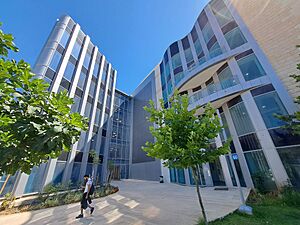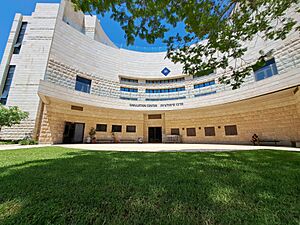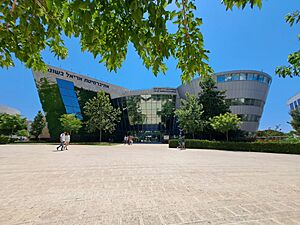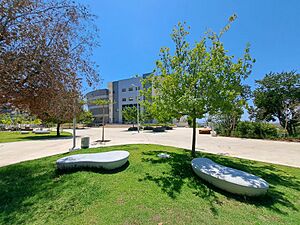Ariel University facts for kids
|
אוניברסיטת אריאל בשומרון
|
|
 |
|
| Type | Public |
|---|---|
| Established | 1982 |
| President | Ehud Grossman |
| Rector | Albert Pinhasov |
| Students | approximately 13,500 (as of August 2020) |
| Location |
Ariel
,
Judea and Samaria Area
32°06′17″N 35°12′34″E / 32.10472°N 35.20944°E Building details
|
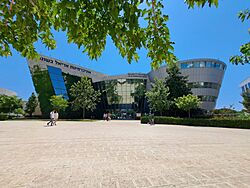 |
|
| Campus | urban |
| Colors | Teal, navy and white |
| Affiliations | IAU |
| Website | English Hebrew |
Ariel University (Hebrew: אוניברסיטת אריאל) is a public university in Israel. It is located in the city of Ariel. Before becoming a university, it was known as the Ariel University Center of Samaria.
The university started as a branch of Bar-Ilan University in 1982. It was first in Kedumim but later moved to Ariel. There, it grew into a large campus. In 2004, it became an independent college.
In 2012, a special council voted to make it a full university. Many important people, including the Prime Minister, supported this decision. By 2013, most people in Israel also supported it.
Ariel University offers many study programs. Students can earn bachelor's, master's, and even doctorate degrees. In 2011, about 14,000 students attended the university. All its degrees are officially recognized.
Contents
Becoming a University
In 2005, the Israeli government wanted the college to become a university. However, the Council for Higher Education in Israel had to approve this change. In 2006, the Council decided not to approve any new universities for five years.
The idea of upgrading the college was a topic of discussion. Some international groups had concerns about its location. Despite this, the college was renamed "Ariel University Center of Samaria" in 2007.
Even though it was renamed, it did not get full university status right away. The Council for Higher Education officially approved it in July 2012. In December 2012, the Israeli Defense Minister also recognized it as a university.
In 2018, a new law was passed. This law placed all Israeli colleges in the Judea and Samaria Area under the same authority as other Israeli universities. This meant they were all supervised by the Council for Higher Education in Israel.
Students and Teachers
Around 14,000 students attend Ariel University. These students come from many different backgrounds. They include Jewish, Arab, Druze, and Circassian Israeli students. The university also has the largest number of Ethiopian-born students in Israel.
In 2011, about 600 Arab students were enrolled. These students generally feel welcome and do not experience unfair treatment. The university also has teachers with different viewpoints.
Guest Teachers
Ariel University often hosts teachers from other countries. These guest teachers come from universities worldwide. For example, in 2010, a professor from the University of Hartford taught a course on communication.
A British professor, Geoffrey Alderman, also teaches at Ariel University. He believes that the university is a place for education for all students. Another guest lecturer, Professor Hilde Leone, spoke about architecture.
Working with Other Countries
Ariel University is part of the International Association of Universities. This means it connects with universities around the world.
The university has agreements with over 51 higher education institutions. These partners are in many countries, including the United States, Russia, France, and Germany. There is even a partnership with the University of Toronto for an MBA program.
In 2008, a group called the Global Association of Risk Professionals started a branch at the university. They hold courses and international meetings there. In 2011, Ariel University also signed an agreement with the Skolkovo innovation center in Russia. This helps Israeli companies connect with resources and people.
Ariel University also takes part in the Masa Israel Journey project. This program brings Jewish students from around the world to study in Ariel. Many of these students choose to move to Israel after the program.
Academic Discussions
Because of its location, Ariel University has been part of some academic discussions. In 2005, a British academic group briefly stopped working with Bar-Ilan University due to its links with the college. This decision was later changed.
In 2009, the Spanish Housing Ministry did not allow the university to join an architectural competition. The Spanish government explained this was because of the university's location.
In 2011, 165 Israeli academics stated they would not work at the university. They felt that Ariel was not part of Israel's main territory.
Ariel University does not receive funding from some international programs. This is due to its location. In 2018, some famous scientists asked others not to attend a conference at Ariel University. They wanted to avoid normalizing the situation in the Palestinian territories.
Important Teachers
- Mel Alexenberg (born 1937), an artist
- Edward Bormashenko (born 1962), who leads the Laboratory of Polymers
- Dani Dayan (born 1955), a lecturer at Ariel
- Israel Hanukoglu, a professor of biochemistry and molecular biology
- Ram Karmi (1931–2013), an architect
- Dan Meyerstein (born 1938), a former president of the university
See also
 In Spanish: Universidad de Ariel para niños
In Spanish: Universidad de Ariel para niños
- Education in Israel
- List of Israeli universities and colleges
- Samaria


